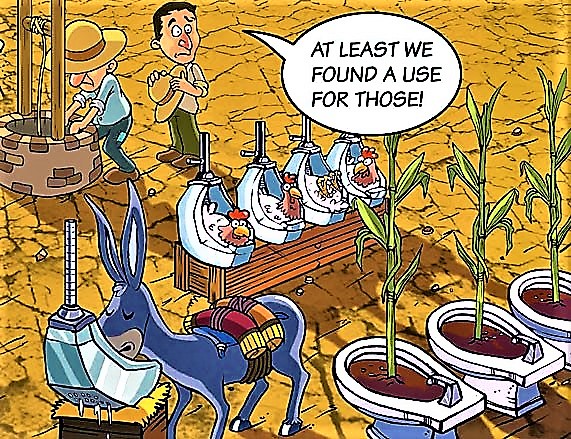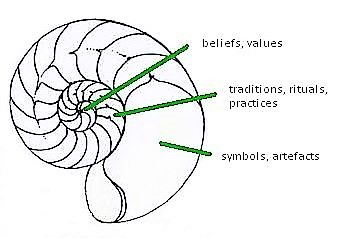(Adapted from SCHELWALD & REIJERKERK 2009 and WARNER et al. 2008)
Among experts, the impact of societal and cultural aspects related to the use and the reuse of water and to human excreta is unquestioned. Technical concepts imported to another region without considering the cultural context have too often caused failure. Local beliefs, traditions and practices, but also gender and generational differences have hence become a decisive factor in planning and operating of water and sanitation.

The cultural context of the users may act as an enabling factor or as a counteracting force for good water management. By assessing cultural backgrounds of the users, one can raise ownership and increase the potential of success, or, on the other hand, mitigate risks of failure. Failure could mean that systems are not used, or worse, are sabotaged.
To consider beliefs and traditional practices becomes even more evident when promoting the treatment of excreta for further use, as claimed by sustainable sanitation and IWRM concepts. Different groups of people have varying, culturally determined relations to human excreta, which affect the acceptance of their treatment.
Water and culture
(Adapted from SCHELWALD & REIJERKERK 2009 and WARNER et al. 2008)

Any relations between people and their environment are embedded in culture (UNESCO 2003). Due to the elementary role of water for people’s life, the way to treat, handle and use water has ever been anchored in people’s cultural values and traditional practices. Therefore, we have to acknowledge that solutions which are developed and maintained by the local people themselves stand the best chance of long-term success of water and sanitation systems and sustainable resource management.
We can learn from the ways that cultures around the world have adapted themselves to living with water in different environments, quantities and qualities. The multitude of traditions coping with their particular climate and environment constitutes in itself a treasure of sustainable practices and innovative approaches to water management.
Culture is considered as a system of shared values, beliefs, behaviour and symbols that the members of society groups use to interact with their social surrounding. The way in which cultures manifest themselves is made tangible through three different categories and symbolised by the Nautilus shell:
Values, norms and beliefs form the core of any culture
They express feelings and affections e.g. towards what is dirty / clean. Often, they are based on historic circumstances, which do not correspond to today’s living environment any more.
Examples:
- A river we classify as filthy and unhealthy may not be regarded as such by locals living adjacent to it. They might have adopted the belief that water from that river is healthy from their ancestors, when this was actually the case.Yet today, the perception of the water quality would not any more correspond to the reality. In brief, beliefs in water quality might persist even when one would think it is obvious to everybody that it is not anymore.
- In Islamic countries and many traditional cultures, according to cultural and religious belief, the water use should be free of charge. This makes it challenging to convince people to pay for water supply services.
Traditions, rituals and practices characterise a culture
Examples:
- The long-standing tradition of women and girls carrying buckets of water on their heads implies their responsibility to choose water sources along economic, quality and social criteria. It is also an important social event when women meet and communicate at the water sources (WIJK-SIJBESMA 1998).
- In a rural village in southern Africa, good quality drinking water was traditionally fetched at the river. When industrialisation and wastewater discharge upstream started to impair the water quality, waterborne diseases like diarrhoea started to increase. In order to improve the situation, a local NGO proposed to use sand filters: they are cheap, do not use electricity and can be made from locally available material. A good idea – as it seemed. However, the NGO had not taken into consideration cultural values of the community. Historically, they were used to only drink running water because in their experience water in stagnant pools was not doing any good to their health. And because water coming from a sand filter stands for a day while being processed, the users refused to drink it, although the water quality was very good.
- In the Netherlands, dykes were built and are maintained (“polder” system) in order to reclaim land from the sea on which to live and work. It has its place in national identity e.g. in literature.
- “Karez” or “Qanat” systems in arid regions (e.g. Afghanistan, Spain, and Atacama) are ancient underground irrigation systems which mitigate the problem of evaporation losses. The systems use gravity to bring ground water to the surface, usually far from the source.
- Rain dances in Africa or the U.S. that are performed to ensure water for people, cattle and crops.
Symbols and artefacts like expressions, stories, gestures or pictures are expressions of culture
Therefore, using culturally known symbols and stories to convey messages about water and sanitation can be of value especially in the education.
(Adapted from WARNER et al. 2008)
There are clear differences of attitudes towards the use of sanitation facilities and the handling of excreta between diverse cultures. Despite an instinctive repulsion towards excreta, our cultures influence our attitudes towards handling of excreta.This applies in special for sustainable sanitation as its operation and maintenance has a broader impact on people’s life (DRANGERT 2004).
A differentiation between people being more or less repelled by excreta is not possible along national boundaries. India,for example, is commonly referred to as a faecophobic culture (PEUSER 2009), where the Dalit cast (the Untouchables), living at the bottom of society are responsible for excreta removal (GNANAKAN 2008). On the other hand experiences have proved, that by establishing closed-loop sanitation systems, a change towards reducing cultural stigmatisation of faeces is possible too (HEEB & GNANAKAN 2008).In areas with predominant cultivation of land and little livestock farming (e.g. some areas in China), people realised the fertilising potential of human excreta and therefore developed more positive affinity towards it.
Even when poverty is being reduced and potable water available, cultural attitudes and social habits may impair people from the use or avoidance of infrastructure considered hygienic and sanitary by today’s standards. Hence hygiene promotion (e.g. through PHAST) in the context of introducing sanitation systems should always be considered.
(Adapted from: JENSSEN et al. 2004)
Religions vary considerably in addressing excreta. In the Bible, the act of elimination is mentioned only once, and it does not address the subject of using excreta for agricultural purposes.
The Koran, however, prescribes strict procedures to limit contact with faecal material, including its use in agriculture, because excrement is considered impure.
The principal Hindu text that details the code of conduct for rituals, the Artha Veda, clearly specifies the use of water for personal hygiene.
But nowhere do we find excrement included more in a religious context than in Buddhism. An integral dimension of Buddhism is reincarnation, which promotes the harmonious concept of recycling life’s treasures; it is therefore not surprising that Buddhist cultures treat earthly resources similarly.
Especially in developing countries, women are promoters, educators and leaders of home and community-based sanitation practices. But in water, sanitation and hygiene, women’s concerns are rarely addressed appropriately due to societal or cultural barriers (SuSanA 2009). Because the question which roles women can play within a social group is strongly determined by the conditions under which they live, their respective culture, the traditions and the education level in this social group (FALKENMARK 2005)(see also water sanitation and gender).
To respect the cultural context means taking into consideration not only religious and non-religious beliefs and values, traditional practices, but also how different cultural groups cope with gender and generational differences.Water and sanitation experts nowadays urge to take these contextual aspects into consideration. It should be part of the research, the planning & design phase and also the monitoring phase. But it is not only about considering these issues, but also about implementing them in the projects or programmes. Cultural competence is crucial for successful and sustainable implementation of project.
(A rather sophisticated concept to systematically assess and mitigate adverse cultural impacts of innovations and developments is the so called “cultural assessment technique”; see SAGNIA 2004).
Towards Hydrosolidarity: Ample Opportunities for human ingenuity. Fifteen-Year Message from the Stockholm Water Symposia, in co-operation with the Symposium Scientific Programme Committee Stockholm International Water Institute
M4: Management: Planning, Implementation and Operation. Social and Cultural Aspects of Eco-Sanitation. A closer look at the Indian context
This presentation elaborates on the socio-cultural and economic context of India and its impact on sanitation and social justice. It proposes proactive steps related to the promotion of ecological sanitation.
GNANAKAN, K. (2008): M4: Management: Planning, Implementation and Operation. Social and Cultural Aspects of Eco-Sanitation. A closer look at the Indian context. In: HEEB, J. ; JENSSEN, P. ; GNANAKAN ; CONRADIN, K. ; (2008): Ecosan Curriculum 2.3. Switzerland, India and Norway: .Source Separation. New toilets for Indian slums. Project paper
Ecological Sanitation and Reuse of Wastewater. Ecosan. A Thinkpiece on ecological sanitation
This paper shows that there are comprehensive experiences and available technologies that meet new and sustainable sanitation requirements. Ecological sanitation constitutes a diversity of options for both rich and poor countries, from household level up to wastewater systems for mega-cities and needs to become recognised by decision-makers at all levels.
JENSSEN, P.D. HEEB, J. HUBA-MANG, E. GNANAKAN, K. WARNER, W. REFSGAARD, K. STENSTROEM, T.A. GUTERSTRAM, B. ALSEN, K.W. (2004): Ecological Sanitation and Reuse of Wastewater. Ecosan. A Thinkpiece on ecological sanitation. Norway: The Agricultural University of Norway URL [Accessed: 19.04.2010]Ecological Sanitation – Eine Konfrontation mit sozialen Hygienetabus am Beispiel von Nepal und Uganda
Framework for Cultural Impact Assessment, International Network for Cultural Diversity (INCD)
Water: A Way of Life. Sustainable Water Management in a Cultural Context
SuSanA Factsheet: Integrating a Gender Perspective in Sustainable Sanitation
This publication gives good background information on the pressing need to integrate a gender perspective into the efforts to promote safe and sustainable sanitation. Most of the information from the text above is taken from this factsheet.
SUSANA (2009): SuSanA Factsheet: Integrating a Gender Perspective in Sustainable Sanitation. Eschborn: Sustainable Sanitation Alliance Working Group on Gender URL [Accessed: 10.10.2012]M4-2: Socio-Cultural Aspects of Ecological Sanitation
This presentation is adapted from the Ecosan Curriculum 2.2. The ecosan curriculum was created in order to compile the large amount of information in a structured and comprehensive way. This is a summary about socio-cultural and religious aspects of sanitation.
WARNER, W. HEEB, J. JENSSEN, P. GNANAKAN, K. CONRADIN, K. (2008): M4-2: Socio-Cultural Aspects of Ecological Sanitation. PDF-Presentation. Aarau: seecon URL [Accessed: 02.10.2012]Gender In Water Resource Management Supply and Sanitation. Roles and Realities Revisited
This book investigates how gender is present in the newly emerging principles on the sustainable management of water resources. The book also reviews how these gender specific principles are currently applied in the water supply, sanitation and hygiene sector.
WIJK-SIJBESMA, C. van (1998): Gender In Water Resource Management Supply and Sanitation. Roles and Realities Revisited. The Hague: International Water and Sanitation Centre (IRC) URL [Accessed: 19.05.2019]WSP Water Calendar
M4: Management: Planning, Implementation and Operation. Social and Cultural Aspects of Eco-Sanitation. A closer look at the Indian context
This presentation elaborates on the socio-cultural and economic context of India and its impact on sanitation and social justice. It proposes proactive steps related to the promotion of ecological sanitation.
GNANAKAN, K. (2008): M4: Management: Planning, Implementation and Operation. Social and Cultural Aspects of Eco-Sanitation. A closer look at the Indian context. In: HEEB, J. ; JENSSEN, P. ; GNANAKAN ; CONRADIN, K. ; (2008): Ecosan Curriculum 2.3. Switzerland, India and Norway: .Cultural Preferences in Designing Ecological Sanitation Systems in North West Frontier Province, Pakistan
A case study in a rural Muslim community to investigate cultural factors affecting the choice of sanitation solutions. The study underlines the importance of incorporating cultural preferences in the planning of improved sanitation, particularly when designing low-cost ecological systems.
NAWAB, B. NYBORG, I. ESSER, K. JENSSEN, P. (n.y): Cultural Preferences in Designing Ecological Sanitation Systems in North West Frontier Province, Pakistan.Water and Cultural Diversity. Proceedings of the Theme
Subjects elaborated in this report with various contributions: translating the cultural dimensions of water into action; water management and cultural heritage; indigenous worldviews and spirituality; community life and water management; indigenous water vision and rights – a new perspective for better water management. Includes contributions from experts, practitioners, indigenous peoples and the general public from various disciplines and knowledge systems.
UNESCO (2006): Water and Cultural Diversity. Proceedings of the Theme. Kyoto: Third World Water ForumM4-2: Socio-Cultural Aspects of Ecological Sanitation
This presentation is adapted from the Ecosan Curriculum 2.2. The ecosan curriculum was created in order to compile the large amount of information in a structured and comprehensive way. This is a summary about socio-cultural and religious aspects of sanitation.
WARNER, W. HEEB, J. JENSSEN, P. GNANAKAN, K. CONRADIN, K. (2008): M4-2: Socio-Cultural Aspects of Ecological Sanitation. PDF-Presentation. Aarau: seecon URL [Accessed: 02.10.2012]Culture’s Influence. Towards Understanding Stakeholder Interactions in Rural Water, Sanitation and Hygiene Promotion Projects
This thesis establishes that the inadequate consideration of cultural characteristics interactions between and within project stakeholders is a major reason for variations between intended and actual outcomes of rural water, sanitation and hygiene promotion projects. A conceptual framework of cultural dimensions is being developed and applied to a variety of stakeholder groups. Exhaustive and scientific approach.
WEBSTER, J. (2006): Culture’s Influence. Towards Understanding Stakeholder Interactions in Rural Water, Sanitation and Hygiene Promotion Projects. (= PhD Thesis ). Institute of Water and Environment, Cranfield UniversitySchool Menstrual Hygiene Management in Malawi: More than Toilets
This study identifies the needs and experiences of girls regarding menstruation. It draws upon participatory group workshops, a questionnaire and semi structured interviews with school-age girls in Malawi to make various recommendations, including lessons about menstrual hygiene management (MHM), girl-friendly toilet designs, and the provision of suitable and cheap sanitary protection.
PIPER-PILLITTERI, S. (2012): School Menstrual Hygiene Management in Malawi: More than Toilets. London: WaterAid URL [Accessed: 17.03.2012]Norms and Attitudes towards Ecosan and other Sanitation Systems
This desk study gives insight how people perceive and understand ecosan and other sanitation systems. It is the result of a cooperation between six experts working with ecosan, analysing the norms and attitudes in their country(Ethiopia, Mexico, Kenya, Tanzania, Uganda, and Sweden). Emphasis is put on individual values and societal norms in urban areas of countries with different socio-economic status and varying ethnic backgrounds.
DRANGERT, J.O. (2004): Norms and Attitudes towards Ecosan and other Sanitation Systems . (= EcoSanRes paper ). Stockholm: SEI URL [Accessed: 18.12.2012]Experiences in Setting Up Ecosan Toilets in Shoreline Settlements in Uganda
In 2000, three pilot ecosan toilets with agricultural reuse were setup in two Ugandan districts. Operation and maintenance by the end users proved a nightmare since sustainability, multicultural and religious issues were some of the aspects initially not considered. This led to the failure of the system to separate faeces and urine and be able to dehydrate the former. Further sensitisation of the population was repeated and after three months the operation and maintenance of the system improved.
KAGGWA, R. KIWANUKA, S. OKURUT OKIA, T. BAGAMBE, F. KANYESIGYE, CH. (n.y): Experiences in Setting Up Ecosan Toilets in Shoreline Settlements in Uganda. Lake Victoria Environmental Management ProjectTowards Total Sanitation. Socio-cultural barriers and triggers tot total sanitation in West Africa
This report documents the results of studies on open defecation in rural communities and the cultural values that reinforce its practices carried out by WaterAid in Burkina Faso, Ghana, Mali, and Nigeria. In these countries, the practice of open defecation is surrounded by cultural taboos and beliefs. Because some communities where Water Aid works are particularly resistant to abandoning open defecation, a series of in-country studies have been carried out to identify the socio-cultural barriers specific to communities in the region.
WATERAID (2009): Towards Total Sanitation. Socio-cultural barriers and triggers tot total sanitation in West Africa.Sanitation as if it really matters: Taking toilets out of the (water) closet and into the loop
This nine-page publication focuses on some of the social-cultural aspects of ecological sanitation promotion, such as the common assumptions and misconceptions related to cultural barriers and taboos, particularly in terms of talking about sanitation practices. It looks at how attitudes change and why “talking toilets” is important.
SAWYER, R. (2003): Sanitation as if it really matters: Taking toilets out of the (water) closet and into the loop. Tepoztlan: SARARhttp://www.geerthofstede.nl/
A useful tool understanding differences in cultures was developed by Dutch sociologist Geert Hofstede. According to him, cultures vary along five dimensions: individualism and collectivism; power-distance aspects; uncertainty avoidance; masculinity – femininity; short term and long-term orientation.
http://pakistaniat.com/
This news article describes how UN reconstruction efforts in Balochistan (Pakistan) focus on restoring the Karez systems, traditional underground water distribution networks.
http://www.who.int/water_sanitation_health/
Celebrating water for life: The International Decade for Action 2005-2015. An advocacy guide.
http://www.genderandwater.org/
The mission of GWA is to promote women’s and men’s equitable access to and management of safe and adequate water, for domestic supply, sanitation, food security and environmental sustainability. GWA believes that equitable access to and control over water is a basic right for all, as well as a critical factor in promoting poverty eradication and sustainability. It contains materials in French, Spanish, Portuguese and Arabic.
SaniPath Rapid Assessment Tool
The SaniPath Rapid Assessment Tool is designed to assess risk related to poor sanitation and to help prioritize sanitation investments based on the exposures that have the greatest public health impact.


